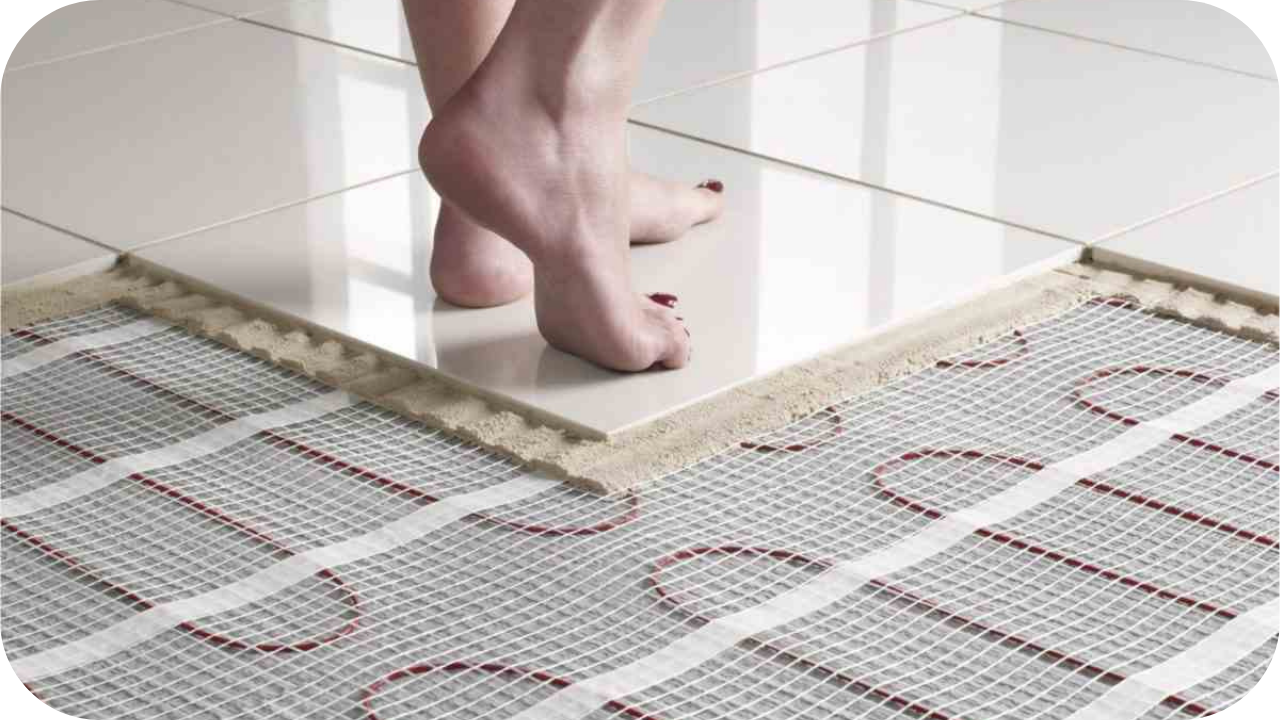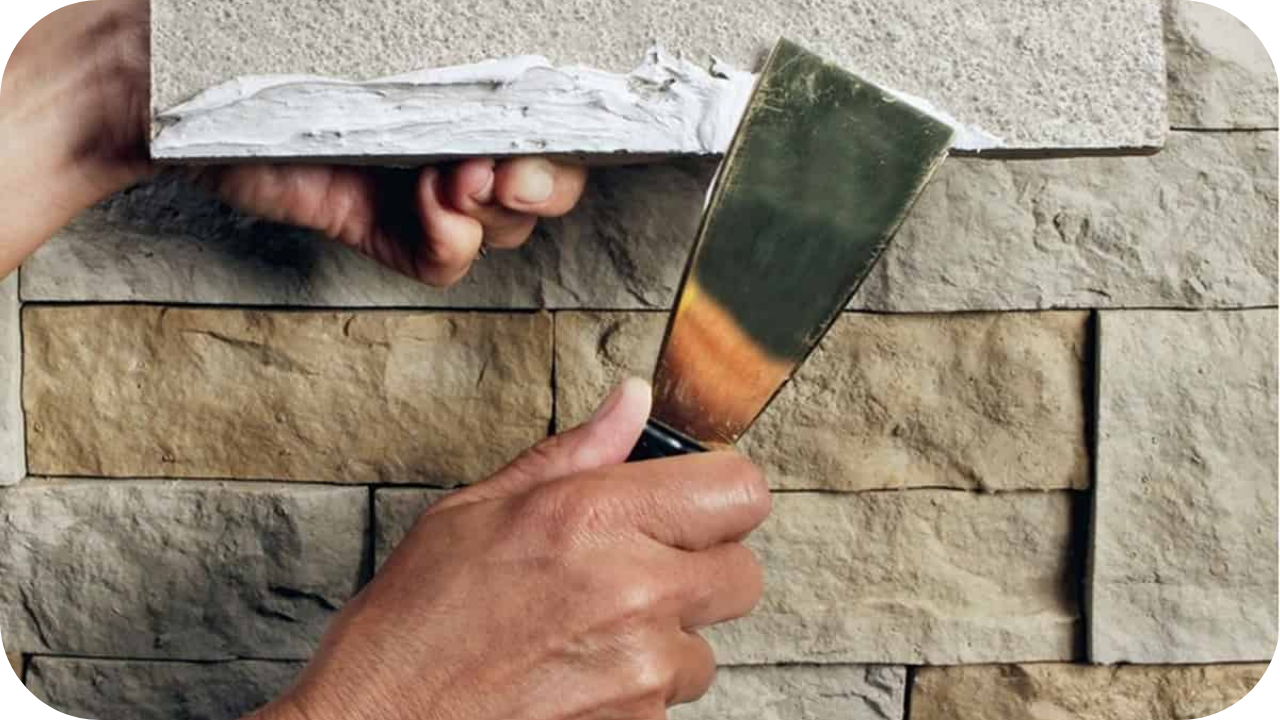
Natural stone has long been a favourite for those who want elegance and durability in their flooring.
Combine it with underfloor heating, and you get a solution that offers comfort and style throughout the year. While this pairing may sound ideal, there are important factors to consider before making a decision.
In this guide, we will discuss the advantages and potential downsides of installing underfloor heating beneath natural stone. Our goal is to help you make an informed choice that suits your home and lifestyle.
What Is Underfloor Heating and How Does It Work?
Underfloor heating is a system that gently warms a room from the ground up, creating a consistent and comfortable indoor temperature.
There are two main types: electric systems that use heating cables, and hydronic systems that circulate warm water through pipes. Both are hidden beneath the floor surface and operate quietly without the need for radiators.
This makes them ideal for modern, open-plan spaces where aesthetics matter. Kitchens, bathrooms, and living areas are the most popular places for installation.
When paired with natural stone, heat travels evenly across the surface, radiating upward to warm the room. Stone’s excellent thermal conductivity allows it to absorb and retain heat efficiently, making it a practical match for this type of heating solution.
The Pros of Underfloor Heating with Natural Stone
Natural stone and underfloor heating are more than just a stylish pairing. They offer real benefits in comfort, efficiency, and design freedom. Here are the key advantages you should know:
1. Delivers Excellent Heat Retention
Natural stone absorbs and holds heat for extended periods. Once warmed by the system, it continues to release gentle heat into the room, reducing the need for constant energy input and helping maintain indoor comfort.
2. Improves Energy Efficiency
Thanks to its natural conductivity, stone heats up faster and retains warmth longer. This reduces heating time and power consumption, making it a cost-effective option for energy-conscious households over the long term.
3. Creates Even, Consistent Warmth
Underfloor heating spreads heat uniformly beneath the entire surface. Stone enhances this effect by eliminating cold patches and delivering balanced warmth that feels especially welcoming in larger or open-plan spaces.
4. Enhances Interior Style and Space
Without the need for radiators, you regain full control of wall space and layout. Natural stone adds a refined, high-end finish that complements contemporary, classic, or rustic interior design schemes.
5. Supports a Cleaner Living Environment
This heating method does not circulate dust, allergens, or pollutants through the air. Combined with the easy-to-clean surface of stone, it promotes a healthier space for families and allergy sufferers alike.
6. Reduces Noise and Echo in Living Spaces
Natural stone combined with underfloor heating reduces the need for forced-air systems, which can generate noise. The solid surface also helps minimise echo, especially in open-plan layouts or large rooms.
7. Offers Long-Term Durability
Stone is resistant to everyday wear and performs well under the consistent warmth of underfloor heating. When installed correctly, it can last for decades with minimal maintenance and no surface warping.
8. Increases Property Value
Homes with underfloor heating and high-quality stone flooring are often viewed as premium. This combination can boost resale value, attracting buyers seeking comfort, aesthetics, and energy-efficient upgrades.
The Cons of Underfloor Heating with Natural Stone
While the benefits are clear, there are also a few challenges to consider before installing underfloor heating with natural stone. Understanding these will help you plan better and avoid costly surprises.
1. Involves High Upfront Installation Costs
Natural stone is a premium material, and installing underfloor heating beneath it requires skilled labour and additional materials. The combined cost can be significantly higher than standard flooring systems.
2. Requires Subfloor Preparation and Structural Review
Stone tiles are heavy, which means your subfloor must be strong and level. Older homes or raised floors may need reinforcement or professional assessment before installation.
3. Demands Specialist Installation Expertise
Incorrect installation can lead to cracking or uneven heating. Both the stone layer and the heating system must be handled by professionals with experience in integrated floor heating solutions.
4. Not Ideal for All Stone Types
Some stones, like porous limestone, may need sealing or careful system calibration. Failing to match the right stone to the system can affect both performance and longevity.
Best Natural Stones for Underfloor Heating
Not all natural stones perform equally when paired with underfloor heating. The ideal stone should conduct heat efficiently, retain warmth, and suit your interior style. Below are the best options:
- Granite: Granite’s density and low porosity make it excellent for heat retention. Charcoal Granite pavers with a flamed finish offer sleek durability for modern, high-traffic spaces.
- Quartzite: Quartzite conducts heat efficiently and suits elegant interiors. Andorra Quartzite pavers feature a natural split finish and refined texture, which is ideal for stylish heated indoor or outdoor flooring.
- Limestone: Limestone performs well when sealed. Himalayan Limestone has a warm tumbled finish for rustic spaces, while Stamford Limestone offers smooth grey tones for modern design schemes.
- Travertine: Travertine warms effectively and suits classic interiors. Silver Travertine pavers feature layered grey tones and texture, adding comfort and character to living areas and sunlit rooms.
- Marble: Marble adds refined warmth and elegance when sealed. Ocean Grey Marble with a honed finish and soft veining works beautifully in bathrooms or focal flooring areas.
- Bluestone: Bluestone’s heat response varies. Honed Bluestone pavers offer a smooth, matte surface suited for modern interiors with proper subfloor support and professional installation.
- Porphyry: Porphyry heats slowly but is durable. Filetti Porphyry features narrow earthy strips for design-led spaces, best used in smaller, less frequently heated areas.
Cost Overview: Is It Worth the Investment?
Underfloor heating with natural stone involves a higher upfront cost than conventional systems. The expense covers not only the heating system but also premium materials, installation, insulation, and floor preparation.
However, the long-term benefits often outweigh the initial outlay. Stone’s ability to retain heat efficiently can reduce energy bills over time, especially in well-insulated homes.
Additionally, the luxurious look and added property value make it a smart investment for homeowners seeking comfort and lasting appeal. When chosen carefully and installed professionally, it’s a feature that pays off both functionally and aesthetically.
Maintenance and Longevity Tips
Natural stone with underfloor heating can last for decades when properly cared for. Here’s how to keep your stone floors looking beautiful and performing well year after year.
- Use pH-neutral cleaners: Avoid acidic or abrasive products that can dull or damage the surface. Instead, clean with pH-neutral solutions to maintain the stone’s natural finish and prevent long-term wear.
- Seal porous stones regularly: Travertine, limestone, and marble should be sealed every one to two years. Sealing prevents moisture absorption, staining, and heat-related surface stress in heated environments.
- Avoid sudden temperature changes: Always warm the floor gradually. Rapid heat increases can create thermal shock, which may cause surface cracks or stress lines in certain stone types over time.
- Inspect grout and joints: Regularly examine grout lines for cracking or movement, especially in frequently used areas. Keeping joints intact ensures structural stability and reduces the risk of tile shifting.
- Clean up spills promptly: Natural stone can absorb spills quickly if left untreated. Wipe up liquids as soon as they occur to avoid staining and maintain an even, clean surface.
- Place protective pads under furniture: Heavy items can scratch or stress heated stone floors. Use felt or rubber pads beneath table legs and chairs to reduce pressure and surface abrasion over time.
FAQs About Underfloor Heating with Natural Stone
Before committing to installation, it helps to know the practical details. Here are quick answers to common questions homeowners often ask.
1. Can underfloor heating crack stone tiles?
Yes, if the system is installed incorrectly or the stone is heated too rapidly, cracking can occur.
2. Will it work in older homes?
Yes, but the subfloor may need assessment and reinforcement to support the stone’s weight and heating system.
3. How long does it take to heat up?
Typically between 30 to 60 minutes, depending on the stone type and system used.
4. Can you retrofit underfloor heating beneath stone?
Yes, but it may raise floor levels and require professional installation to ensure performance and safety.
5. Do all stone types need sealing?
No, but porous stones like limestone and travertine do benefit from regular sealing.
Conclusion
Underfloor heating paired with natural stone flooring offers a blend of comfort, efficiency, and elegance. While the initial investment may be higher, the long-term benefits make it a worthwhile consideration for many homeowners.
Need help choosing the right stone? Get in touch with Splendour in Stone for expert guidance and premium stone selection.
More To Explore

How to Choose the Right Adhesive for Installing Stone Cladding
Choosing the wrong adhesive for stone cladding can lead to cracking, detachment, or even structural failure. All that hard work could fall apart in months

Stone Options for Modern Home Designs
Modern homes demand high-quality materials that combine style with strength. But with so many options available, choosing the right stone can feel overwhelming. Many people


